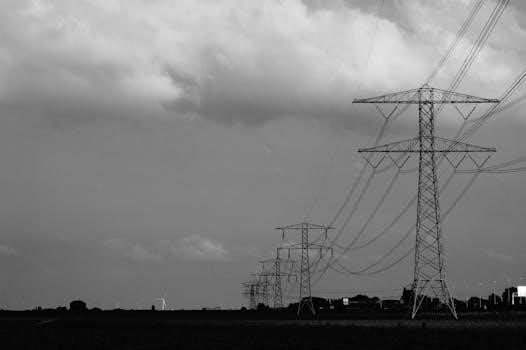
Neutral Safety Switch in Manual Transmissions⁚ An Overview
The neutral safety switch, often called a clutch safety switch in manual transmissions, serves as a crucial safety mechanism. Its primary function is to prevent the vehicle from starting unless the clutch pedal is fully depressed. This feature prevents unintended movement during ignition, thereby enhancing overall vehicle safety.
Primary Function of the Neutral Safety Switch
The primary function of the neutral safety switch in a manual transmission vehicle is to act as a safety interlock, preventing the engine from starting if the transmission is engaged in any gear. This crucial role ensures that the vehicle does not unexpectedly move when the ignition is activated. By requiring the clutch pedal to be fully depressed, the switch interrupts the starting circuit, preventing the engine from cranking. This mechanism is vital for preventing accidents, particularly if the vehicle was left in gear unintentionally. The neutral safety switch provides a critical layer of protection, ensuring the vehicle remains stationary during the starting sequence. It plays an integral part in preventing sudden and uncontrolled movements that could potentially lead to collisions or injuries. This foundational safety feature is paramount in the operation of manual transmission vehicles.
Clutch Safety Switch⁚ The Manual Transmission Equivalent
In the context of manual transmissions, the neutral safety switch is often referred to as the clutch safety switch, highlighting its specific function related to the clutch pedal. This switch serves the same primary purpose as the neutral safety switch in automatic transmissions, which is to prevent the engine from starting unless specific conditions are met. However, instead of responding to the gear selector position, the clutch safety switch is activated by the depression of the clutch pedal. This mechanism is essential for safety, ensuring that a manual transmission vehicle cannot be started while in gear, which could lead to sudden and uncontrolled movements. The clutch safety switch ensures that the transmission is disengaged before the engine can be started, preventing any potential accidents associated with unexpected lurches. This crucial component is integral to the safe operation of manual transmission vehicles.
Location of the Switch in Manual Transmissions
The clutch safety switch, acting as the neutral safety switch equivalent in manual transmissions, is typically found in proximity to the clutch pedal assembly. This placement is crucial for its proper function, enabling it to detect the position of the clutch pedal. Usually, the switch is located on the clutch linkage, often near the pedal itself, where it can directly interact with the movement of the clutch pedal. The physical location ensures that when the clutch pedal is depressed, it activates the switch, completing the electrical circuit necessary for starting the engine. The precise location can vary slightly depending on the vehicle make and model, but the general principle of being positioned to sense clutch pedal movement remains consistent. This strategic placement is vital for the switch’s intended role in preventing unintended vehicle movement during engine start-up.
How the Switch Prevents Unintended Movement
The clutch safety switch in a manual transmission acts as an electrical gatekeeper, strategically preventing the engine from starting unless the clutch pedal is fully engaged. This mechanism is essential to ensure that the transmission is disengaged from the engine before ignition. By requiring the driver to press the clutch pedal, the switch interrupts the electrical circuit that allows power to reach the starter motor. This interruption ensures that the vehicle will not lurch forward or backward due to being in gear when the engine starts. If the vehicle were in gear and the engine started without the clutch engaged, the sudden transfer of power to the wheels could lead to an uncontrolled movement, potentially causing damage or injury. The clutch safety switch prevents this scenario, making it a vital safety component of manual transmission systems. It ensures that engine start-up occurs only when the driver is in full control.

Activation of the Switch by the Clutch Pedal
The clutch safety switch, integral to manual transmission vehicles, is specifically designed to be activated by the movement of the clutch pedal. This activation is a crucial part of the starting process, ensuring the vehicle’s safety. When the clutch pedal is depressed, it engages the switch, completing an electrical circuit that allows the starter motor to receive power. This electrical circuit is only completed when the pedal is fully pressed. This design ensures that the starting process is directly tied to the driver’s action of disengaging the transmission. Conversely, when the clutch pedal is released, the switch disengages, preventing the starter from activating. This design avoids the car starting while the transmission is engaged, preventing unexpected movement. The switch’s sensitivity to the clutch pedal’s position is paramount for safe vehicle operation. It’s a simple yet effective safety measure, closely integrated with the mechanical action of the clutch pedal.
Role in the Starting Process
The neutral safety switch, or clutch safety switch in manual transmissions, plays a vital role in the vehicle’s starting sequence. It acts as an essential intermediary between the ignition system and the engine starter. Specifically, this switch enables the engine to start only when the clutch pedal is fully depressed, thereby ensuring the transmission is disengaged. When the driver turns the ignition key, the electrical current must pass through the activated neutral safety switch to reach the starter motor. If the clutch pedal is not depressed, the switch remains open, preventing the circuit from completing and thus, preventing the engine from starting. This mechanism is crucial for preventing the car from lurching forward upon ignition if it’s left in gear. This switch is not merely a convenience feature but a fundamental safety component, ensuring the vehicle starts only under safe conditions. Its role is to protect against unintended movement, contributing significantly to overall driver and passenger safety.

Consequences of a Faulty Switch
A faulty neutral safety switch in a manual transmission can manifest in several problematic ways, impacting the vehicle’s starting system significantly. One of the most common symptoms is the inability to start the engine, even when the clutch pedal is fully depressed. This occurs because the faulty switch fails to complete the electrical circuit required to engage the starter motor. Conversely, in some cases, the engine might start without requiring the clutch pedal to be pressed, which is a dangerous condition. Such a scenario poses a risk of the vehicle lurching forward if it’s in gear, potentially leading to accidents. Furthermore, an intermittent failure of the switch can cause inconsistent starting issues, making it unreliable and unpredictable. Diagnosing a faulty switch usually requires testing the electrical continuity of the switch and the wiring connected to it. A defective neutral safety switch not only affects the vehicle’s operability but also compromises essential safety features, highlighting the importance of timely repairs.
Relationship to the Ignition System

The neutral safety switch, or clutch safety switch, plays a critical role in the ignition system of a manual transmission vehicle. This switch acts as an intermediary, controlling the flow of electrical current between the ignition switch and the starter motor. When the clutch pedal is fully depressed, the switch closes the circuit, allowing electricity to reach the starter, thus enabling the engine to turn over. Conversely, when the clutch pedal is released, the circuit remains open, preventing the starter from engaging. This mechanism is vital for ensuring that the vehicle does not start while in gear, thereby preventing potential accidents. Without a functioning neutral safety switch, the ignition system would not be able to differentiate between a safe and unsafe starting condition. This interlock with the ignition system highlights the safety critical nature of the neutral safety switch in manual vehicles.

Difference from Automatic Transmission Systems
The neutral safety switch in a manual transmission operates differently compared to its counterpart in automatic systems. In automatic vehicles, the switch is typically located on the transmission case and is activated by the gear selector, ensuring the car starts only in ‘Park’ or ‘Neutral.’ In contrast, manual transmissions utilize a clutch safety switch, which is engaged by the clutch pedal. This difference arises from the fundamental mechanics of the two transmission types. Automatic transmissions rely on the gear selector to determine the safe starting position, whereas manual transmissions depend on the driver disengaging the transmission via the clutch. This distinction dictates the location and activation of the safety switch. Furthermore, the automatic system prevents starting if the car is in gear, while the manual switch prevents starting unless the clutch is pressed, thus reflecting a core difference in their operational mechanics and safety protocols. These differences are necessary for the unique functions of manual and automatic systems.
Additional Safety Functions
Beyond its primary role in preventing unintended starts, the clutch safety switch, or neutral safety switch in manual transmissions, also contributes to overall vehicle safety in several subtle ways. By requiring the driver to depress the clutch pedal before starting, it reinforces the habit of consciously disengaging the transmission before ignition. This practice is crucial in preventing the vehicle from lurching forward, especially in situations where the driver might have accidentally left the car in gear. Additionally, some advanced systems might integrate the clutch safety switch with other safety features, such as preventing the starter from engaging if other conditions aren’t met, further reducing the chance of unexpected movement. The switch is also a part of a broader network of sensors and interlocks designed to protect the driver and the vehicle. These added functions highlight the importance of a properly functioning switch in maintaining a secure driving environment. These functions also support the driver’s awareness of the vehicle’s mechanical state.